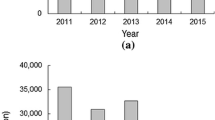Abstract
Fishing is a major local industry in Malaysia, particularly in rural areas. However, the rapidly increasing price of fuel is seriously affecting the industry’s viability. At present, outboard petrol engines are the preferred choice for use in small-scale fishing boats because they deliver the advantages of high speed and low weight, they are easy to install, and they use minimal space. Petrol outboard engines are known to consume a greater amount of fuel than inboard diesel engines, but installing diesel engines with conventional submerged propellers in existing small-scale fishing boats is not economically viable because major hullform modifications and extra expenditure are required to achieve this. This study describes a proposal to enable reductions in fuel consumption by introducing the combined use of a diesel engine and surface-piercing propeller (SPP). An analysis of fuel consumption reduction is presented, together with an economic feasibility study. Resulting data reveal that the use of the proposed modifications would save 23.31 liters of fuel per trip (40.75 %) compared to outboard motors, equaling annual savings of RM 3962 per year.
Similar content being viewed by others
References
Ahmad AT, Salim K, Ean CP, Isa MM, Fong LC, 2003. An overview of the socioeconomic status of fisheries in Malaysia. The world fish center working papers. Retrieved from http://www.worldfishcenter.org/resource_centre/AMF_Chapter-23-FA.p df.
Banawan AA, Mosleh M, Seddiek IS, 2013. Prediction of the fuel saving and emissions reduction by decreasing speed of a catamaran. Journal of Marine Engineering & Technology, 12(3), 40–48. DOI: 10.1080/20464177.2013.11020287
Buhaug Ø, Corbett JJ, Endresen Ø, Eyring V, Faber J, Hanayama S, Yoshida K, 2009. Second IMO GHG Study. International Maritime Organization (IMO), London, UK.
Dahou K, Déme M, & Dioum A, 2001. Socio-economic and environmental impact of Senegalese fishery support mechanisms. UNEP, Geneva. 34.
Department of Fisheries Malaysia, 2011. Annual Fisheries Statistics Book. Retrieved from http://www.dof.gov.my.
FAO, 1995. Summary report of the CRODT/FAO CECAF ad hoc technical meeting on economic aspects of the exploitation of sardinellas and other small pelagic species off the Northwest African coast CRODT, Dakar. FAO, Rome.
Ferrando M, Crotti S, Viviani M, 2002. Performance of a family of surface piercing propellers. Royal Institution for Naval Architects (RINA) Transactions Part A, 11.
Gulbrandsen O, 1986. Reducing the fuel costs of small fishing boats. FAO Bay of Bengal Programme, 28.
Ghassemi H, 2009. Hydrodynamic characteristic of the surface-piercing propellers for the planning craft. Journal of Marine Science and Application, 8, 267–274. DOI: 10.1007s11804-009-8076-2
Hadler JB, 1996. On partially submerged propeller propulsion. Workshop on Unconventional Propulsion, ITTC, Norway, 186–190. Retrieved from http//:ittc.sname.org/proc21/Unconventional%20Propulsion.pdf.
Hydrocompinc Inc., 2007. NavCad manual. Retrieved from http://hydrocompinc.com/software/navcad.
Jaichandar S, Annamalai K, 2011. The status of biodiesel as an alternative fuel for diesel engine-An Overview. Journal of Sustainable Energy & Environment, 2, 71–75.
Kelleher K, Arnasson R, Willmann R, 2008. The Sunken Billions: the economic justification for fisheries reform. World Bank, Agriculture and Rural Development Department–and Food and Agriculture Organization, Washington, DC, 80.
MacPherson DM, 2003. Comments on reliable prediction accuracy. A HydroCamp Technical Report. Retrieved from www.hydrocompinc.com/knowledge/whitepapers/HC103-Relia blePrediction.pdf.
Mohd Pauzi AG, Yaakob O, Ahmad Fuaad AS, 1991. Powering estimates of deep sea fishing boat. National Seminar on Fishing Technology, Universiti Pertanian Malaysia, Kuala Terengganu.
Nagi J, Nagi SKAF, 2008. Palm biodiesel an alternative green renewable energy for the energy demands of the future. International Conference on Construction and Building Technology (ICCBT), 79–94.
Radojcic D, Matic D, 1997. Regression analysis of surface piercing propeller series. Paper presented at NAV & HSHV International Conference. Naples-Sorento, Italy. Retrieved from http://mararchief.tudelft.nl/catalogue/entries/13132/.
Savitsky D, Brown P, 1976. Procedures for hydrodynamic evaluation of planning hulls in smooth and rough water. Marine Technology, 13(1), 381–400.
Schneiders CC, 1990. Should ship performance be predicted by calculation?. Naval Architect, 6, E250–E261.
Seddiek IS, Mosleh MA, Banawan AA, 2013. Fuel saving and emissions cut through shore-side power concept for high-speed crafts at the red sea in Egypt. Journal of Marine Science and Application, 12(4), 463–472. DOI: 10.1007/s11804-013-1218-6
Sherbaz S, Duan W, 2012. Operational options for green ships. Journal of Marine Science and Application, 11(3), 335–340.
Suhaimi NAM, Hussein MA, Latiff I, Mohayidin G, 2011. The level of technical efficiency of the inshore fishermen in Kuala Terengganu. Economic and Technology Management Review, 6, 83–91.
Sumaila UR, Teh L, Watson R, Tyedmers P, Pauly D, 2008. Fuel price increase, subsidies, overcapacity, and resource sustainability. ICES Journal of Marine Science: Journal du Conseil, 65(6), 832–840. DOI: 10.1093/icesjms/fsn070
Suuronen P, Chopin F, Glass C, Løkkeborg S, Matsushita Y, Queirolo D, Rihan D, 2012. Low impact and fuel efficient fishing—looking beyond the horizon. Fisheries Research, 119, 135–146. DOI: 10.1016/j.fishres.2011.12.009
Wilson JD, 1999. Food and Agriculture Organization of the United Nations. Fuel and Financial Savings for Operators of Small Fishing Vessels. Rome.
Author information
Authors and Affiliations
Corresponding author
Rights and permissions
About this article
Cite this article
Zainol, I., Yaakob, O. Use of diesel engine and surface-piercing propeller to achieve fuel savings for inshore fishing boats. J. Marine. Sci. Appl. 15, 214–221 (2016). https://doi.org/10.1007/s11804-016-1336-z
Received:
Accepted:
Published:
Issue Date:
DOI: https://doi.org/10.1007/s11804-016-1336-z




